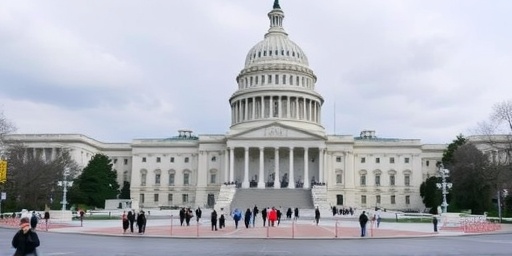As the federal Government shutdown stretches into its 34th day, it has now tied the record for the longest in U.S. history, leaving millions of Americans grappling with disrupted federal services and mounting economic pressures. This milestone, reached on a crisp winter morning, underscores the deepening divide in Washington over border security funding and highlights the human cost of partisan gridlock.
- Historical Parallels: The 1995-1996 Shutdown That Set the Mark
- Federal Services in Crisis: TSA Delays and Food Aid Shortfalls Grip the Nation
- Human Stories Emerge: Furloughed Workers Face Uncertain Futures
- Economic Ripples Spread: Billions in Losses and Long-Term Damage
- Pathways to Resolution: Bipartisan Talks Heat Up as Pressure Mounts
Historical Parallels: The 1995-1996 Shutdown That Set the Mark
The current Government shutdown has eclipsed previous impasses, matching the infamous 21-day closure from December 1995 to January 1996 under President Bill Clinton. That earlier event, triggered by disputes over the federal budget between Clinton and Republican congressional leaders, resulted in the furlough of 800,000 federal workers and cost the economy an estimated $1.4 billion in lost productivity, according to the Office of Management and Budget.
Fast-forward to today, and the parallels are striking but the stakes feel higher. The 1995 shutdown forced the closure of national parks, delayed tax refunds, and even led to the temporary shutdown of the White House tour program. Historians note that public opinion shifted dramatically against the Republicans after that episode, contributing to Clinton’s re-election. In contrast, the ongoing longest shutdown is fueled by President Donald Trump’s demand for $5.7 billion in wall funding along the U.S.-Mexico border, clashing with Democratic opposition in a divided Congress.
Experts like Dr. Julian Zelizer, a professor of history and public affairs at Princeton University, remarked in a recent interview, ‘This isn’t just about records; it’s about how shutdowns have evolved from brief annoyances to weapons in our polarized political arsenal.’ Zelizer points out that while the 1995 event was resolved through bipartisan negotiation, today’s impasse shows no signs of quick resolution, with both sides digging in deeper on day 34.
To put this in perspective, the U.S. has endured 21 shutdowns since 1976, totaling over 100 days of closure. The 2013 shutdown lasted 16 days, costing $24 billion, per the Congressional Budget Office. Yet none matched the endurance test of 1995-1996 until now. As furloughed workers return to unpaid labor or seek temporary jobs, the history of these events serves as a cautionary tale of governance fragility.
Federal Services in Crisis: TSA Delays and Food Aid Shortfalls Grip the Nation
On day 34 of the Government shutdown, the ripple effects on federal services are palpable from coast to coast. At major airports, Transportation Security Administration (TSA) officers, working without pay, are calling in sick at alarming rates, leading to widespread delays. Data from the Department of Homeland Security shows that wait times at security checkpoints have surged by 20% on average, with some hubs like Atlanta’s Hartsfield-Jackson International Airport reporting lines stretching over an hour during peak travel seasons.
‘It’s chaos out there,’ said TSA spokesperson Michael McCarthy in a statement released yesterday. ‘Our dedicated workforce is showing up despite the hardships, but the strain is evident.’ Over 50,000 TSA employees are affected, many juggling second jobs to make ends meet. Passengers, especially holiday travelers, are venting frustration online, with #ShutdownDelays trending on social media platforms.
Beyond aviation, food assistance programs are buckling under the pressure. The U.S. Department of Agriculture’s Supplemental Nutrition Assistance Program (SNAP), which serves 40 million low-income Americans, faces processing backlogs that could delay benefits for thousands. In states like California and New York, where demand is highest, local food banks report a 15% uptick in visits as families stretch their resources thin. A report from the Center on Budget and Policy Priorities estimates that every week of the shutdown costs SNAP participants up to $100 million in delayed aid.
National parks and monuments, shuttered since December 22, continue to lose revenue—over $50 million by some counts—while maintenance crews are absent, raising concerns about long-term damage from weather exposure. IRS tax refunds, typically processed swiftly in January, are now in limbo, affecting an estimated 10 million filers who rely on those funds for winter bills.
These disruptions aren’t abstract; they’re daily realities. In Washington, D.C., federal contractors like those maintaining Smithsonian museums are out of work, idling projects worth millions. The shutdown’s breadth touches everything from passport processing—backlogged by 300,000 applications—to wildlife research, where scientists monitoring endangered species have halted fieldwork.
Human Stories Emerge: Furloughed Workers Face Uncertain Futures
Behind the statistics are personal narratives of resilience and hardship. Sarah Jenkins, a 42-year-old IRS auditor from Virginia, has been furloughed since the shutdown began. ‘I’ve got two kids and a mortgage,’ she shared in an emotional interview with local news. ‘We’re dipping into savings, but how long can that last on day 34?’ Jenkins represents over 800,000 federal employees now without paychecks, many required to work unpaid in ‘essential’ roles.
In the private sector, the fallout is equally severe. Small businesses near federal installations, such as cafes in Quantico, Virginia, report 30% drops in revenue as military personnel conserve cash. John Ramirez, owner of a diner outside Andrews Air Force Base, told reporters, ‘These folks are my bread and butter. Without them eating here, I’m barely scraping by.’ A survey by the National Federation of Independent Business found that 40% of small firms with government ties are considering layoffs if the government shutdown persists.
Veterans’ services are another casualty. The Department of Veterans Affairs has furloughed 10,000 staff, leading to longer wait times for claims processing. Veteran advocate Tom Simmons, from the American Legion, warned, ‘Our heroes who served deserve better than this bureaucratic nightmare. Delays could mean life-or-death for some seeking benefits.’
Immigration enforcement adds another layer of complexity. With Customs and Border Protection agents working unpaid, border apprehensions have reportedly decreased, but so has routine inspections at ports of entry. This has sparked debates among lawmakers, with some Republicans arguing it bolsters the case for wall funding, while Democrats highlight humanitarian crises at detention centers running low on supplies.
Public sentiment is shifting, polls indicate. A recent Quinnipiac University survey shows 51% of Americans blame President Trump for the longest shutdown in history, up from 45% a week ago. Bipartisan frustration is growing, with even some GOP senators calling for compromise.
Economic Ripples Spread: Billions in Losses and Long-Term Damage
The financial toll of this government shutdown is staggering, with economists projecting losses exceeding $11 billion by the end of the month. The Congressional Budget Office, in a preliminary analysis, estimates that GDP growth could shave off 0.1% for every week the impasse continues, translating to about 13,000 fewer jobs created quarterly.
Consumer confidence is plummeting; the Conference Board’s index dipped to 97.2 in December, the lowest since 2014. Stock markets have been volatile, with defense contractors like Lockheed Martin seeing share dips due to halted contracts. Tourism, a $2.5 trillion industry, is hit hard—Yellowstone National Park alone loses $500,000 daily when closed.
On the fiscal front, the Treasury Department reports that while some bills are being paid through borrowing, the shutdown complicates debt ceiling negotiations set for March. Rating agencies like Moody’s have issued warnings that prolonged closures could affect the U.S. credit rating, echoing the 2011 debt crisis.
Regionally, impacts vary. In Alaska, Coast Guard personnel are unpaid amid harsh weather, delaying search-and-rescue operations. Midwest farmers, awaiting USDA loans for crop insurance, face planting delays that could cost billions in yields. A study by the American Farm Bureau Federation predicts a $1.5 billion hit to agriculture if resolutions drag into spring.
Internationally, the shutdown undermines U.S. credibility. Trade talks with China have stalled as Commerce Department officials are sidelined, and diplomatic posts abroad operate at reduced capacity, per State Department memos.
Pathways to Resolution: Bipartisan Talks Heat Up as Pressure Mounts
As day 34 fades into evening, glimmers of hope emerge from Capitol Hill. House Speaker Nancy Pelosi announced yesterday that Democrats are open to a short-term funding bill excluding wall provisions, potentially ending the longest shutdown temporarily. Senate Majority Leader Mitch McConnell, previously a staunch Trump ally, hinted at flexibility during a closed-door meeting.
President Trump, in a White House address, reiterated his stance but acknowledged the ‘tough choices’ ahead. ‘We’re close to a deal that secures our borders without compromising safety,’ he said, though details remain vague. Negotiators from both parties are scheduled for weekend sessions, with Treasury Secretary Steven Mnuchin playing a mediating role.
Advocacy groups are ramping up pressure. The Partnership for Public Service launched a campaign urging Congress to prioritize back pay for workers, while economic think tanks like the Brookings Institution call for shutdown-proof budgeting reforms to prevent future crises.
Looking ahead, resolution could come swiftly if cooler heads prevail, but experts warn of recurrence without addressing root causes like immigration reform. For the 800,000 affected families, every day counts toward financial recovery. As one lawmaker put it, ‘History won’t remember the wins; it’ll remember the unnecessary pain inflicted on everyday Americans.’ The nation watches, hoping day 35 brings relief rather than another unwelcome record.









